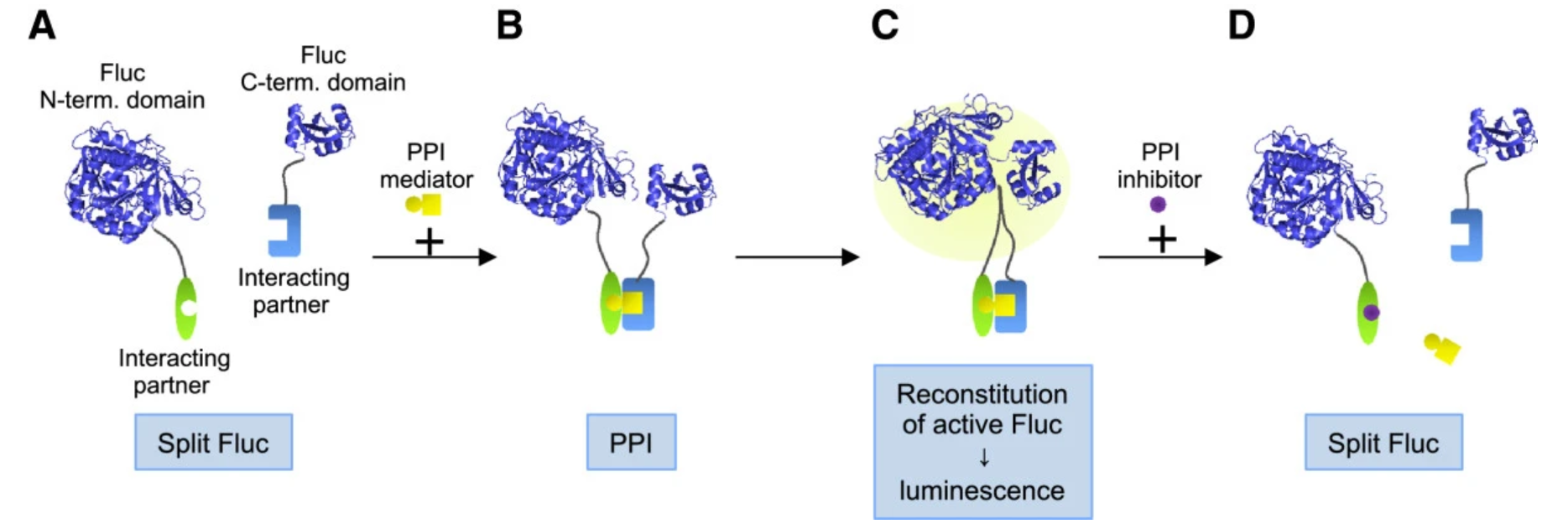Protein Fragment Complementation Assays Service
- Drug Discovery and Target Validation
- Biomarker Discovery
- Signal Transduction Pathways
- Protein Complex Assembly
- Studying Protein-Protein Interactions in Disease Models
Protein fragment complementation assays (PCA) are cutting-edge techniques designed to study protein-protein interactions with high sensitivity and specificity. The fundamental principle behind protein fragment complementation assays is the splitting of a reporter protein or enzyme into two non-functional fragments. These fragments are individually fused to the proteins of interest, and when these proteins interact, the fragments come together, reassembling into a functional reporter. This reconstitution of the reporter's activity provides a measurable signal, typically through luminescence, fluorescence, or enzymatic activity. Protein fragment complementation assays offer a unique advantage by enabling the detection of protein interactions in living cells under native conditions, allowing for real-time monitoring of complex biological processes such as signal transduction, molecular assembly, and protein conformational changes.

Figure 1. Principle of Protein Fragment Complementation Assays using Purified Firefly Luciferase Fragments
Protein fragment complementation assays play a crucial role in the study of protein-protein interactions (PPIs), which are fundamental to understanding cellular functions and molecular mechanisms. By detecting interactions that may otherwise be difficult to measure using traditional techniques, PCA provide unparalleled sensitivity. Protein fragment complementation assays allow researchers to identify weak or transient interactions, which are often overlooked by methods such as co-immunoprecipitation or yeast two-hybrid screening. Additionally, PCA offer spatial and temporal resolution, enabling real-time analysis of PPIs within live cells, thereby reflecting the dynamic nature of cellular environments. Protein fragment complementation assays have proven essential for advancing research in areas such as drug discovery, biomarker identification, and the understanding of disease mechanisms.
Services at MtoZ Biolabs
MtoZ Biolabs offers state-of-the-art Protein Fragment Complementation Assays Service designed to support a wide range of research applications. Our service empowers researchers to explore protein-protein interactions with high accuracy, sensitivity, and reproducibility. Whether investigating signaling pathways, mapping interaction networks, or validating therapeutic targets, our team provides tailored solutions to meet your specific research needs. With advanced instrumentation and expert support, our Protein Fragment Complementation Assays Services enable you to track real-time interactions in live cells and uncover insights into the molecular underpinnings of disease. MtoZ Biolabs' Protein Fragment Complementation Assays Service is the ideal tool for researchers looking to gain a deeper understanding of protein dynamics in their biological systems.
Why Choose MtoZ Biolabs?
1. Advance Analysis Platform: MtoZ Biolabs established an advanced Protein Fragment Complementation Assays Service platform, guaranteeing reliable, fast, and highly accurate analysis service.
2. Real-time In Vivo Monitoring: Monitor protein-protein interactions directly within live cells, capturing dynamic processes as they occur in their native cellular environment.
3. High-Throughput Capability: Supports large-scale screening for drug discovery and biomarker identification, accelerating research with rapid, reproducible results.
4. Versatile Across Experimental Models: Applicable to various biological systems, including mammalian cells, yeast, and bacteria, enabling broad research applications.
5. One-Time-Charge: Our pricing is transparent, no hidden fees or additional costs.
6. High-Data-Quality: Deep data coverage with strict data quality control. AI-powered bioinformatics platform integrates all protein fragment complementation assays data providing clients with a comprehensive data report.
7. Fast Turnaround: The process from sample handling to report generation is efficient, shortening the analysis cycle.
Applications
Our Protein Fragment Complementation Assays Service can be used in:
FAQ
Q1: What are the Commonly Used Reporter Proteins in Protein Fragment Complementation Assays?
In Protein Fragment Complementation Assays, several reporter proteins are commonly used to detect protein-protein interactions. These reporter proteins are split into two non-functional fragments, which reassemble when the target proteins interact. Some of the most frequently used reporter proteins include:
1. Luciferase
Luciferase, commonly used in bioluminescence-based protein fragment complementation assays , emits light upon reconstitution of its fragments. This provides a highly sensitive and quantifiable signal, ideal for detecting low-abundance interactions.
2. Green Fluorescent Protein (GFP)
GFP and its derivatives (such as eGFP or YFP) are often used for fluorescence-based assays. The reassembly of GFP fragments results in fluorescence, enabling real-time, non-invasive monitoring of protein interactions in live cells.
3. β-Galactosidase (β-gal)
β-gal is frequently used in enzyme activity-based assays. When the protein fragments are reconstituted, β-galactosidase activity is restored, providing a measurable enzymatic signal.
4. Alpha-Complementation of LacZ
This is a variation of the β-galactosidase system where the α-complementation of the LacZ gene is used as a reporter. The enzyme activity is restored when the interacting proteins bring together the split LacZ fragments.
5. Dihydrofolate Reductase (DHFR)
DHFR is used in certain protein fragment complementation assays where the reconstitution of its split fragments restores enzyme activity. This is particularly useful for detecting protein-protein interactions in both in vivo and in vitro settings, often combined with metabolic or drug resistance assays.
These reporter proteins are selected based on the specific needs of the experiment, such as the type of signal (bioluminescence, fluorescence, or enzymatic activity), the required sensitivity, and the biological system being studied.
Q2: What are the Key Advantages of Using PCA in Living Cells as Opposed to in Vitro or Cell-Free Systems for Protein-Protein Interaction Studies?
Using protein fragment complementation assays in living cells offers several key advantages over in vitro or cell-free systems. It enables the detection of protein-protein interactions in their native cellular context, preserving the full complexity of the cellular environment. This allows for real-time monitoring of dynamic interactions, accounting for factors like cellular localization, post-translational modifications, and environmental cues that may influence interactions. Additionally, PCA in living cells eliminates artifacts associated with isolated systems, providing more accurate and biologically relevant results for studying transient or weak interactions.
MtoZ Biolabs, an integrated chromatography and mass spectrometry (MS) services provider.
Related Services
Protein-Protein Interaction Analysis Service
How to order?







